|
Activity Trackers
Author:
Stan Reents, PharmD
Original Posting:
12/05/2014 06:07 AM
Last Revision: 12/10/2018 05:34 AM
Wearable activity monitors have become very popular lately. In fact, a Pew survey conducted in 2013 revealed that 69% of Americans were already tracking at least one health parameter on a regular basis. In early 2014, 1 in 10 adults (in the US) owned an activity tracker device.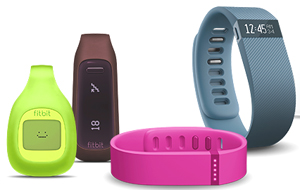
In 2013-2014, these products began appearing in mainstream consumer publications like Money and Costco's member magazine. Consumer Reports reviewed them in their November 2013 issue. Beginning in 2014, the Wall St. Journal maintains a regularly-updated review of activity trackers. The November 14, 2014 issue of Time magazine included an article titled "The Doctor on Your Wrist," by Bryan Walsh, who is a marathon runner and uses Jawbone's UP24 activity tracker. Also in November 2014, ads for FitBit began airing on TV in the US, a first for devices like this.
"Activity monitors," "activity trackers," "fitness bands," "smart bands," "wearable fitness technology," "wearable monitors".....all of these terms are used to describe activity- and physiology-tracking devices...
Because tracking steps or sleep cycles or calculating calories burned has nothing to do with "fitness" per se, I don't like the terms "fitness bands" or "wearable fitness technology." Also, "wearable tech" doesn't seem like a very useful label either. So, I am going to refer to them generally as "activity trackers."
A BRIEF HISTORY OF WEARABLE FITNESS TECHNOLOGY: From Monitoring "Activity" to Monitoring "Physiology"
Wearable activity monitors for consumers -- ie., pedometers, heart rate monitors, and activity trackers -- arrived on the scene some time around the 1980's (John D, et al. 2012), though, the military was investigating activity trackers before these consumer products became commercially available. Polar led the way with heart rate monitors. They produced their first wearable heart rate monitor in 1986.
Then, GPS functionality was incorporated into these wrist watch-like devices. GPS technology allowed us to track not only how far we ran or biked, but the exact route we followed. This was pretty cool! Companies like Garmin and Suunto were leaders here.
Then, the ability to monitor details of exercise physiology migrated out of the lab and into these wearable devices:
• In 1997, the Cambridge, MA-based start-up FitSense Technology, Inc. was formed. With venture capital from Motorola, they produced wireless devices and systems that captured data on human activity. (Today, their wireless activity tracker "Pebble+" is getting lots of attention....see below.)
• Somewhere around 1999-2000, another Boston-area start-up BodyMedia, Inc. was founded. They released their first wearable physiology-tracking device -- the "SenseWear® Pro Armband" -- in 2001. In 2003, they released an updated model: the "Pro2". This armband was also marketed as the "BodyBugg" by Apex Fitness and as the "HealthWear® System" by Roche Diagnostics. (source: BodyMedia white paper, 2006).
• James Park co-founded FitBit in 2007. This activity tracker quickly became popular. In August 2010, the original FitBit was profiled in Money magazine. At that time, their device could count steps, calculate calories burned, and track your sleep patterns. Several research studies have revealed that FitBit devices are very accurate.
Tracking More Than Activity
Now, we have wearable devices that will track not only our activities, but, also, our physiology:
TRACKING ACTIVITY
(MOVEMENT) |
TRACKING PHYSIOLOGY |
• step-counting
• sleep cycles
• GPS |
• calories burned
• heart rate
• hydration status
• lactic acid
• metabolic rate
• muscle contractions
• oxygen saturation
• skin temperature |
And, there are thousands of apps that can utilize these data points!
Along the way, the line between using activity trackers as a fitness device vs. using them to track health parameters became blurry. Today, it doesn't even exist any more. In 2013, the Mayo Clinic provided FitBit activity tracking devices to 150 heart-surgery patients on their 1st day post-op. They found that the patients who took the most steps each day left the hospital earlier and were more likely to return home rather than to a nursing facility. And the Cleveland Clinic has asked all of its employees to use the "Pebble+," an activity tracker made by FitLinxx, Inc. (a division of FitSense Technology, Inc.). People who use this device regularly are eligible for a lower health insurance premium.
The next wave of activity trackers has already appeared: These are activity trackers that possess "intelligence"....ie., as they track more and more of your behavior, they then begin providing personalized guidance. Several of these newest products are discussed at the end of this article.
The Rise of "eHealth" Followed by "mHealth"
• eHealth: On October 4, 2007, Microsoft announced the launch of their "Health Vault." The concept of storing, sharing, and using health and medical information online was here to stay.
• mHealth: In 2008, Apple launched their App Store. Subsequently, the development and marketing of mobile apps exploded (though, both physicians and patients were using PDA's like Palm Pilots for health-related functions long before Apple launched the App Store). As of December 2013, it was estimated that there were over 43,000 mobile apps that could be included in the "health" category (Powell AC, et al. 2014) (Reynolds A. 2014).
The growth in the use of mobile apps and devices that track health-related information has become so significant that the health care community has created the term "mobile health," or "mHealth."
Depending on the level of medical information that these apps and devices collect, increasingly stringent HIPAA regulations apply to ensure the privacy of this sensitive information (Wang CJ, et al. 2013). And, the FDA may even enter the picture! (The FDA regulates medical devices in addition to foods and drugs.)
A simplified explanation of how the FDA views mHealth apps and devices is as follows (Powell AC, et al. 2014):
• an app or device that tracks BLOOD GLUCOSE and makes recommendations on INSULIN DOSES requires FDA approval.
• an app or device that tracks BODY WEIGHT and makes recommendations on EXERCISE does not require FDA approval.
SPECIFIC ACTIVITY / PHYSIOLOGY TRACKERS
With that as background, below are details on some of these products.
...Emphasis on the word "some" in that last sentence. Note that I didn't review every single activity monitor on the market....that would make this article ridiculously long.
I'll group them according to where they are worn because that seems to predict which physiologic parameters they are best at tracking. For example, measuring body temperature on the head might be more accurate than measuring it on the wrist. And, a sensor that is placed directly over a muscle can assess muscle physiology better than a wrist band.
On The Wrist
Wrist devices can be categorized as (a) "smart watches" or (b) "wrist bands": The Pebble Steel is a good example of a smart watch, whereas the Nike+ FuelBand and the FitBit FLEX are examples of wrist bands.
However, there's a lot of overlap in these devices: The Samsung Gear Fit, the Microsoft Band, and the FitBit SURGE attempt to be both.
I'll go a step further and group smart watches into 2 sub-categories: "nerdy-looking" (Pebble Steel) and "really elegant" (Misfit Shine, Withings Activite).
Several of the more popular wrist-based devices are summarized below:
FitBit: As of May 2017, FitBit markets 8 different models; several are featured in the photo at the top of this article. (In February 2014, the company recalled the FORCE after it was discovered to cause skin irritation in 1.7% of users. This was blamed on the nickel coating.) The original FitBit (now called FitBit ONE) was a clip-on device: you wore it on your pocket or waistband. They now offer 2 clip-ons: FitBit ONE and FitBit ZIP. These are summarized later. Four models are worn on the wrist: FLEX, CHARGE, CHARGE-HR, and SURGE. In lieu of wearing it on the wrist, FitBit FLEX can be carried in your pocket. (www.FitBit.com):
| DETAILS: |
FitBit
FLEX |
FitBit
CHARGE |
FitBit
CHARGE-HR |
FitBit
SURGE |
| List Price: |
$100 |
$130 |
$150 |
$250 |
| Tracks steps: |
YES |
YES |
YES |
YES |
Tracks
active minutes: |
YES |
YES |
YES |
YES |
| Tracks sleep: |
YES |
YES |
YES |
YES |
| Tracks HR: |
no |
no |
YES |
YES |
Reports calories
& distance: |
YES |
YES |
YES |
YES |
| Clock: |
no |
YES |
YES |
YES |
| Wake alarm: |
YES |
YES |
YES |
YES |
| Caller ID: |
no |
YES |
YES |
YES |
| Text alerts: |
no |
no |
no |
YES |
| Waterproof: |
YES
OK to swim |
XXX |
XXX |
XXX |
| Battery: |
lithium -
lasts 5 days |
XXX |
XXX |
XXX |
(*above details captured from FitBit web site on January 15, 2015)
Gear Fit ($119 on Amazon Prime, Jan. 2015) (by Samsung): Samsung's Gear Fit is considered a hybrid: ie., it is both a smart watch and a fitness band. It evolved from the now defunct "Galaxy Gear". Adding to the confusion is Samsung's "Gear-2" (a smart watch) and their "Gear-2 Neo". As a fitness band, the Gear Fit will track steps, distance, and your heart rate. As a smart watch, it will provide alerts for incoming e-messages. The Gear Fit looks elegant and can display either in landscape or portrait mode (ie., horizontally or vertically), but a CNET reviewer didn't like the vertical display for reading text. He also didn't like the fact that it only interfaces with Samsung phones. He gave the Gear Fit a "Good" rating in April 2014.
- Gear Fit keeps track of: steps, distance, heart rate
- Other features: not waterproof; battery lasts 3 days
Microsoft Band ($200):  The original Microsoft Band was released in late October 2014. Describing it as an "activity tracker" seems too limiting. Really, it's a personal digital assistant, too. This thing seems to do everything except tell you when to brush your teeth! Actually, it can do that, too, if you want it to: if using Windows Phone 8.1, you can use Cortana to take notes or create reminders with your voice; this service can also provide traffic, stocks, sports, weather notifications. It interfaces with iPhone, Android and Windows phones and will allow you to view incoming calls and voice-mail alerts. You can also view Twitter messages and preview e-mail messages. It comes in 3 sizes: small, medium and large. You can customize the face. It is shown to the right with a purple face. (www.Microsoft.com) The original Microsoft Band was released in late October 2014. Describing it as an "activity tracker" seems too limiting. Really, it's a personal digital assistant, too. This thing seems to do everything except tell you when to brush your teeth! Actually, it can do that, too, if you want it to: if using Windows Phone 8.1, you can use Cortana to take notes or create reminders with your voice; this service can also provide traffic, stocks, sports, weather notifications. It interfaces with iPhone, Android and Windows phones and will allow you to view incoming calls and voice-mail alerts. You can also view Twitter messages and preview e-mail messages. It comes in 3 sizes: small, medium and large. You can customize the face. It is shown to the right with a purple face. (www.Microsoft.com)
- Keeps track of: activity, heart rate, route traveled (via GPS), sleep
- Other features: interfaces with Microsoft Health to provide guided workouts; 24-hr heart rate monitoring; GPS; displays e-mail previews; can provide calendar alerts; has a timer, a clock, and an alarm; even has a UV monitor!; rechargeable battery lasts 48 hrs (less with GPS usage)
Misfit Flash ($50), Misfit Shine ($100): Misfit's Shine looks like an elegant Movado wrist-watch. Their Flash product looks more like a sports watch. Both have a circular face. Tiny LED's light up around the perimeter of the face as you move more. (www.Misfit.com)
- Keeps track of: steps/distance, calories burned, sleep
- Other features: can display current time; waterproof down to 30 meters; battery lasts up to 6 months (not rechargeable, can be replaced)
Nike+ FuelBand SE ($99-$149): Nike's FuelBand SE has been available for several years. It received a lukewarm review on CNET in March 2012.  The reviewer stated that this fitness band awarded him 2500 points for a run in Central Park, 1000 points for an hour of tennis, and 400 points when he was merely sitting in a bar hoisting a couple cold ones! 100 tiny white LED's are used to display information, with an additional row of 20 colored LED's underneath that indicate how close you are to reaching your activity goal. The Fuel score resets to zero every midnight. You cannot swim while wearing it. It comes in 4 styles: Volt (shown here), Pink, Crimson, and Black. (www.Nike.com) The reviewer stated that this fitness band awarded him 2500 points for a run in Central Park, 1000 points for an hour of tennis, and 400 points when he was merely sitting in a bar hoisting a couple cold ones! 100 tiny white LED's are used to display information, with an additional row of 20 colored LED's underneath that indicate how close you are to reaching your activity goal. The Fuel score resets to zero every midnight. You cannot swim while wearing it. It comes in 4 styles: Volt (shown here), Pink, Crimson, and Black. (www.Nike.com)
- Keeps track of: daily activity (does not track sleep)
- Other features: Reports activity in units of "Nike Fuel", Bluetooth 4.0 connectivity, the Nike app is optimized to run on Samsung Galaxy phones
Pebble ($99) and Pebble Steele ($199) SmartWatch (by FitLinxx): The Pebble SmartWatch is more like a smartphone that you wear on your wrist than an activity tracker. I debated whether or not to include it, but, it does contain an accelerometer. It is capable of displaying a wide variety of 3rd-party apps, including RunKeeper and The Weather Channel. It can even display QR codes. The company raised over $10 million on KickStarter to develop Pebble in 2012. The original Pebble smartwatch was launched in 2013; Pebble Steel smartwatch was released in 2014. The Pebble+ is reviewed later. (GetPebble.com)
- Keeps track of: activity, sleep
- Other features: contains an accelerometer, a compass, and a light sensor; water-proof down to 50 meters; battery lasts 7 days
UP24 ($100), UP3 ($180) (by Jawbone): 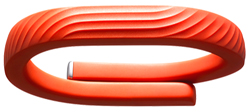 Jawbone (Jawbone.com) is a San Francisco-based company that has created JAMBOX® wireless speakers, ERA® Bluetooth® headsets, and NoiseAssassin® technology. In 2013, Jawbone acquired BodyMedia. Collectively, Jawbone owns and has filed for over 1000 patents. Their first wrist band was called simply the UP. This was replaced by the UP24 (shown here). Their 3rd generation of this activity tracker is called the UP3 (which, I assume, explains the name they gave it). All 3 are wrist bands and, with each successive version, they increase the features. Jawbone issued a press-release announcing the UP3 on November 3, 2014, but, it is uncertain when this model will be commercially available. Jawbone claims the UP3 can differentiate running from playing basketball. They also claim that the UP3 will integrate data on your activity, your sleep, your food intake, and your resting HR and turn that into personalized guidance. On their web site, Jawbone describes the UP3 as "The World's Most Advanced Tracker" and "The Most Advanced Tracker Known To Man." (I wonder what Microsoft would say about that: Microsoft's Band has features not seen in any of the others I reviewed...ie., stock quotes?!! UV readings?!!). Jawbone also produces a clip-on device called UP Move ($50) which is profiled later. Jawbone (Jawbone.com) is a San Francisco-based company that has created JAMBOX® wireless speakers, ERA® Bluetooth® headsets, and NoiseAssassin® technology. In 2013, Jawbone acquired BodyMedia. Collectively, Jawbone owns and has filed for over 1000 patents. Their first wrist band was called simply the UP. This was replaced by the UP24 (shown here). Their 3rd generation of this activity tracker is called the UP3 (which, I assume, explains the name they gave it). All 3 are wrist bands and, with each successive version, they increase the features. Jawbone issued a press-release announcing the UP3 on November 3, 2014, but, it is uncertain when this model will be commercially available. Jawbone claims the UP3 can differentiate running from playing basketball. They also claim that the UP3 will integrate data on your activity, your sleep, your food intake, and your resting HR and turn that into personalized guidance. On their web site, Jawbone describes the UP3 as "The World's Most Advanced Tracker" and "The Most Advanced Tracker Known To Man." (I wonder what Microsoft would say about that: Microsoft's Band has features not seen in any of the others I reviewed...ie., stock quotes?!! UV readings?!!). Jawbone also produces a clip-on device called UP Move ($50) which is profiled later.
| DETAILS |
UP24 |
UP3 |
| Price: |
$100 |
$180 |
| Worn On: |
wrist |
wrist |
| Keeps Track Of: |
• steps
• distance
• calories burned
• sleep |
• steps
• distance
• calories burned
• "stages" of sleep
• resting HR |
| Other Features: |
• vibrates if you have been
inactive too long
• can customize the reminders
you want
• connects with apps, social media,
and other users
• wireless syncing
• available in 2 colors |
• "learns" your behavior
as you use it
• can detect different types
of activities
• workouts are automatically
recognized and logged
• wireless syncing
• available in 2 colors |
| Water Resistant?: |
yes, but cannot submerge |
yes, down to 10 meters,
OK to swim |
| Battery Life: |
10 days |
7 days |
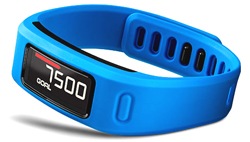
VivoFit ($130), VivoSmart ($170) (by Garmin): After 1-hr of inactivity, the VivoFit and VivoSmart display a red bar which increases every 15 minutes. This encourages you to get up and move. Doing so will reset the red bar back to baseline. This is pretty cool! Both Garmin devices will also track heart rate, but this requires a separate chest strap. You can swim while wearing these Garmin devices. (Garmin.com)
| DETAILS |
VivoFit |
VivoSmart |
| Price: |
$130 |
$170 |
| Worn On: |
wrist |
wrist |
| Keeps Track Of: |
• steps
• distance
• calories burned
• sleep |
• steps
• distance
• calories burned
• sleep |
| Other Features: |
• displays a red band if you have been inactive too long
• displays time
• available in 6 colors |
• displays a red band and vibrates if you have been inactive too long
• "learns" your behavior as you use it
• displays time
• available in 6 colors |
| Water Resistant? |
yes, down to 50 meters |
yes, down to 50 meters |
| Battery Life: |
1 year |
7 days |
On The Upper Arm
BodyMedia, Inc.  released their first wearable tracking device -- the "SenseWear® Pro Armband" -- in 2001. In 2003, they released an updated model: the "Pro2". This armband was mainly designed to track/calculate energy expenditure. It contained a total of 4 sensors which can detect skin temperature, ambient temperature, conductivity of the skin (galvanic skin response), and motion. This armband was also marketed in 2003 as the "HealthWear® System" by Roche Diagnostics and in 2005 as the "BodyBugg" by Apex Fitness. (source: BodyMedia white paper, 2006). released their first wearable tracking device -- the "SenseWear® Pro Armband" -- in 2001. In 2003, they released an updated model: the "Pro2". This armband was mainly designed to track/calculate energy expenditure. It contained a total of 4 sensors which can detect skin temperature, ambient temperature, conductivity of the skin (galvanic skin response), and motion. This armband was also marketed in 2003 as the "HealthWear® System" by Roche Diagnostics and in 2005 as the "BodyBugg" by Apex Fitness. (source: BodyMedia white paper, 2006).
BodyMedia armbands have been used in over 100 research studies. They had excellent accuracy (Johannsen DL, et al. 2010) (Lee J-M, et al. 2014). In 2013, Jawbone acquired BodyMedia. According to the Jawbone web site, the sale of BodyMedia products ceased on October 31, 2014. The BodyMedia service was shut down on January 31, 2016.
On The Chest
There are too many chest straps to include here. I picked this one because it got a good review from a cyclist on the mountain biker web site www.MTBR.com in October 2014:
• Tickr Workout Tracker ($80), Tickr-X Workout Tracker ($100), (by Wahoo Fitness): Wahoo Fitness (gotta love that name!) makes a variety of fitness products. They offer 2 versions of the Tickr "workout tracker": Ticker ($80) and Ticker-X ($100). They also make a "Tickr" heart rate monitor ($60). (www.WahooFitness.com)
- Keeps track of: distance, duration, heart rate, calories burned, cadence (cycling), smoothness (running)
- Other features: works as a stand-alone, or, with an iPhone; compatible with over 50 training apps; sweat tolerant
The cyclist felt it was very easy to set-up and use ("...it's just a sensor on a chest strap with an ANT+/Bluetooth transmitter..."). However, the device is about the size of a credit card and the reviewer felt that it was sometimes uncomfortable to wear. The Tickr will track your route, measure your cadence while cycling, or give you a smoothness score while running. You can set-up the device to initiate a function when you tap twice on the monitor. However, the cyclist found that riding over bumps initiated this. You can also program the device to deliver audio alerts when you reach predetermined milestones.
On The Thigh
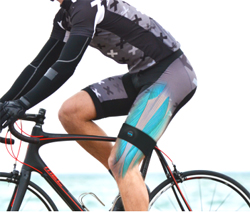
• LEO (by Gesture Logic):
Gesture Logic, a Canadian company, set out to create an activity tracker in a band that goes around your mid-thigh to improve exercise training and sports performance. The LEO would track muscle contractions (EMG), heart rate, movement (via the accelerometer), and sweat (via bioimpedance). These data points would then be used to derive muscle intensity and muscle fatigue, muscle efficiency and imbalance, exercise technique, hydration and lactic acid levels. Impressive! The more you use it, the device would "learn" your patterns and then provide intelligent guidance for subsequent work-outs. The company raised over $140,000 via crowdfunding and anticipated a release date of March 2015. However, the company ran out of funding and announced in March 2016 that development on the LEO had come to an end (source: Indie Go-Go)
On The Calf
BSX Insight (by BSX Athletics) ($300-$420): Houston-based BSX Athletics was founded by 2 medical students in 2012. In early 2014, they launched a KickStarter funding campaign for the development of "BSX Insight." 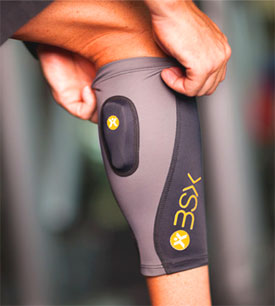 This wearable device is similar in concept to the LEO described above, except that the BSX product is worn on the back of the calf. And, whereas the LEO monitors a variety of exercise physiology parameters, the BSX Insight's main focus is on determining your lactate threshold. BSX Insight estimates lactate levels by using an LED that passes light through the gastrocnemius muscle. By detecting muscle contractions, blood pulsations in the muscle, and changes in hemoglobin saturation, and then combining that with HR monitoring, a person's exercise intensity can be determined. From that, a lactate threshold curve is derived. This helps athletes know when they are training and competing too hard. The company has already received testimonials from marathoners and triathletes stating that they performed better when they were able to monitor their lactic acid levels during a race. Three models are offered: cycling, running, and multi-sport. (www.BSXInsight.com) This wearable device is similar in concept to the LEO described above, except that the BSX product is worn on the back of the calf. And, whereas the LEO monitors a variety of exercise physiology parameters, the BSX Insight's main focus is on determining your lactate threshold. BSX Insight estimates lactate levels by using an LED that passes light through the gastrocnemius muscle. By detecting muscle contractions, blood pulsations in the muscle, and changes in hemoglobin saturation, and then combining that with HR monitoring, a person's exercise intensity can be determined. From that, a lactate threshold curve is derived. This helps athletes know when they are training and competing too hard. The company has already received testimonials from marathoners and triathletes stating that they performed better when they were able to monitor their lactic acid levels during a race. Three models are offered: cycling, running, and multi-sport. (www.BSXInsight.com)
- Keeps track of: lactate levels/lactate threshold, heart rate, pace/speed/cadence, calories
- Other features: available in 3 versions: Running ($300), Cycling ($370), and Multisport ($420)
On The Head
Spree SmartCap ($199) (by Spree Wearables): 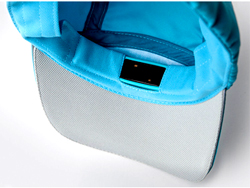 Spree created a headband that hit the market in November 2013. It was essentially a chest strap you wear around your head. But, people didn't like the look or feel of wearing a head strap, so, now, Spree Wearables has hidden it inside a baseball cap. Very cool! The image to the right shows the inside of their baseball cap with the sensor placed so that it resides on your forehead. Measuring body temperature on the head might be more accurate than measuring it at the wrist, as the Microsoft Band does. (Spree SmartCap) Spree created a headband that hit the market in November 2013. It was essentially a chest strap you wear around your head. But, people didn't like the look or feel of wearing a head strap, so, now, Spree Wearables has hidden it inside a baseball cap. Very cool! The image to the right shows the inside of their baseball cap with the sensor placed so that it resides on your forehead. Measuring body temperature on the head might be more accurate than measuring it at the wrist, as the Microsoft Band does. (Spree SmartCap)
- Keeps track of: movement (distance traveled, speed, time), heart rate, calories burned, body temperature
- Other features: the SmartCap is available in black, white, pink, and teal
Eva Zeisel, Spree's VP of Operations, answered a few of my questions (December 15, 2014):
• Any hard data from real athletes? Does it either improve performance, or, reduce the risk of heat injury?: Obviously, you can't intentionally induce heat illness in athletes in a research study. But, Zeisel stated that their heat sensor was evaluated by a high school football team, and, was tested at Georgia State, Georgia Southern, and TCU.
• Can a heat sensor warn me of impending heat illness before I start to feel bad?: Yes, according to Zeisel. Several high-school football players were pulled off the field when the sensor indicated their body temp was getting too high. Spree's research suggests that 102.5 is a critical temperature. Above this temp, heat illness is almost certain.
• How much does direct sunlight affect the heat sensor?: Very little, according to Zeisel.
My thoughts: I'm a tennis player. I lived in Florida for a long time, and, now I live in Phoenix. I know that I do not do well on the court when I get too hot. Thus, I am very intrigued by this product.
Anywhere on the Body
FitBit ONE ($100), FitBit ZIP ($60): The FitBit ONE and the FitBit ZIP are clip-on activity trackers. You attach them to your clothing. The main difference is that the FitBit ONE will track sleep whereas the FitBit ZIP does not. Both of these trackers estimated calories burned very accurately in a research study published in September 2014 (Lee J-M, et al. 2014).
| DETAILS |
FitBit ONE |
FitBit ZIP |
| List Price: |
$100 |
$60 |
| Worn On: |
clip-on |
clip-on |
| Keeps Track Of: |
• steps
• distance
• calories burned
• sleep |
• steps
• distance
• calories burned |
| Other Features: |
available in 2 colors |
available in 5 colors |
| Water Resistant? |
YES, but
cannot submerge |
YES, but
cannot submerge |
| Sweat Resistant? |
YES |
YES |
| Battery: |
rechargeable lithium -
lasts 10-14 days |
3v coin battery -
lasts 4-6 months |
Pebble+ (by FitLinxx): The Pebble+ is a clip-on device, not to be confused with their smartwatches described above. About.com selected the Pebble+ as best computer-linked activity monitor in 2013. Similar to Misfit's Flash and Shine, an increasing number of dots light up around the perimeter of the face as you move more. The Pebble+ is starting to be used in corporate wellness programs. (www.FitLinxx.com)
- Keeps track of: steps, distance traveled and speed, total activity time, calories burned
- Other features: stores 21 days of activity; wireless "walk-by" data uploads; waterproof; non-rechargeable battery lasts up to 12 months
3D Smart Garments (by Performance 3D, LLC): In 2014, Performance 3D, based in Scottsdale, Arizona, began marketing a line of clothing with patent-pending activity-tracking technology embedded into shirts, shorts, and leggings. As of December 15, 2014, very little information is available, however, bicycle-style shorts appear for sale on the 3D Smart Garments web site: (www.3DSmartGarments.com)
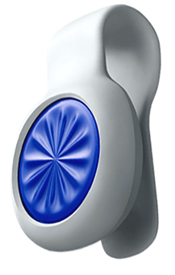
UP Move (by Jawbone) ($50): Shown to the right is Jawbone's clip-on device. Similar to the FitBit ZIP, the UP Move can be worn anywhere: on your shoe, on your pocket, on your waist-band. As of this review (December 16, 2014), the UP Move has just been released. It was reviewed on CNET on November 24, 2014. They gave it a "Very Good" rating, but the reviewer thought that the Misfit Flash was a better $50 device due to being water-resistant.
- Keeps track of: steps, sleep
- Other features: LED display shows daily progress; syncs wirelessly with iOS and Android; does not provide vibration alerts; not water-resistant; replaceable battery lasts 6 months
Withings Pulse O2 ($120): This activity tracker comes with a wrist-band, but, it can also be worn by clipping it on your clothing or just carrying it in your pocket. This appears to be the only device that can track oxygen saturation. (for this, you need to place your fingertip on it). Monitoring O2 saturation is useful at elevated altitudes, but, could be helpful at sea level if you walk/jog/bike next to roads where there is a high amount of vehicle exhaust, or, have sleep apnea. Incorporating GPS functionality would make this device even more attractive to hikers, trail runners, and mountain bikers. (www.Withings.com)
- Keeps track of: steps, distance, calories burned, elevation, heart rate, oxygen saturation, sleep
- Other features: offers real-time coaching with the free Health Mate app (iOS and Android); if you log your meals into MyFitnessPal, these details can be interfaced to compare calories in vs. calories out; battery lasts 2 weeks
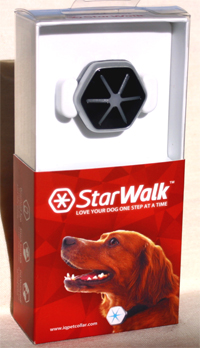
On Your Dog (yes, really...)
And, believe it or not, there are activity trackers that you can put on your dog's collar. One that we looked at is: StarWalk ($100). The manufacturer, iQ Pet, claims that 54% of dogs and cats in the US are overweight. Wednesday October 8th, 2014 was even designated "National Pet Obesity Day."
One of our editorial advisers evaluated this device on her dog for several weeks. She found that syncing it to her smartphone was a bit quirky, but, walking her dog after sunset with the tracker lit-up made her dog the coolest in the neighborhood! (IQPetCollar.com)
ARE ACTIVITY TRACKERS ACCURATE?
These devices collect and report a lot of data! Are they accurate? Keep in mind that an "exact" number may not be an "accurate" number...
The accuracy of the values that these devices report depends on both the hardware and the software. For example, you can shake a pedometer or activity tracker and it will record those movements as steps.
One tester mentioned that if his arm wasn't swinging while he was walking, this appeared to compromise accurate step-counting. Another tester discovered that arm movements from brushing her teeth, or, just opening the refrigerator triggered the Jawbone UP to register steps. A CNET reviewer noticed that simply hoisting a couple mugs of beer while wearing Nike's FuelBand on his wrist earned him 400 points.
Then, because many of the other parameters are based on that count, obviously, these may not be accurate either.
But, let's say that the step count and motion-tracking is perfect. Translating steps or movement into calories burned can be error-prone, too. For example, walking on the ground burns more calories than walking on a treadmill, but how would a device know that?
Accuracy: Step Counts
Patel assessed how accurately these gizmos track steps. He tested each one during a 0.25-mile walk on a treadmill. He counted his steps manually, and, had a 2nd person also count his steps. He repeated this test on a trail walk....same distance, and, again, he and a 2nd person counted his steps manually. Here's what these devices recorded:
| PRODUCT: |
WORN AT |
STEPS DURING:
TREADMILL
WALKING |
STEPS DURING:
TRAIL WALKING |
| • BodyMedia LINK |
upper arm |
-47 steps (-7.6% error) |
-12 steps (-2.2% error) |
| • FitBit ONE |
wrist |
Perfect! (0% error) |
-2 steps (-0.4% error) |
| • Jawbone UP |
wrist |
+1 step (0.2% error) |
Perfect! (0% error) |
| • Nike+ FuelBand |
wrist |
-60 steps (-9.8% error) |
+12 steps (2.2% error) |
Patel then wore them for 28 days. Step-counts during this time ranged from a low of 115,791 steps for the Nike+ FuelBand to a high of 191,514 for the FitBit ONE. That's a pretty wide variance! However, from reading his comments, these numbers might not be very reliable....ie., he stated that he sometimes walks with his hands in his pockets, and, he was carrying boxes one day. If your arm isn't moving, the accelerometer may not detect motion.
Accuracy: Calories Burned
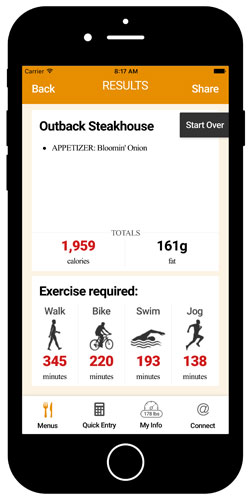 As mentioned above, even if the step count is perfect, the Calories Burned values from some activity trackers may not be accurate. Translating movement into calories is not precise...nor linear (Staudenmayer, et al. 2012). As mentioned above, even if the step count is perfect, the Calories Burned values from some activity trackers may not be accurate. Translating movement into calories is not precise...nor linear (Staudenmayer, et al. 2012).
There can be many reported calorie-burn rates for any activity. For "jogging," for example, it could be slow jogging, moderate jogging, or brisk jogging. There are other variables that determine how many calories you burn when you jog: age, body size, and sex. The environment is another factor. Obviously, running uphill or into a strong headwind burns more calories. If it's cold outside, you might be wearing more clothes, which add weight. More weight also means a higher calorie-burn rate.
Having said that, in order to determine how many calories have been burned, a specific conversion factor must be used in the computational equations.
When I developed our Exercise Calorie Converter, I reviewed the scientific tables from 6 different exercise physiology texts, and, also, the widely-regarded best source for these data: Ainsworth's table of MET values (Ainsworth BE, et al. 2011). I selected a mid-point value from the range of values listed in these 7 tables. Because the goal of our app is to help you make better food selections and not serve as an activity tracker, using a mid-range calorie-expenditure value in the calculations seems acceptable.
Patel assessed the daily "calories burned" values during the 28-day period. He found that the reported values were pretty similar for 3 of the devices. However, the Jawbone UP reported substantially fewer calories each day compared to the other 3.
Patel notes in his review that the Jawbone UP requires you to add 2000 to the value it reports for Calories Burned. The logic here is that 2000 represents the number of calories burned while sleeping and sitting....ie., your basal metabolic rate. Though it's correct that everyone burns calories while sleeping and sitting, a value of 2000 doesn't apply to everyone.
In September 2014, a research study from U. Nebraska and Iowa State comparing the accuracy of the Calories Burned values from common activity trackers was published in Medicine and Science in Sports and Exercise. The error rate of these devices was reported as follows (a lower error rate equates to a higher level of accuracy):
| ACTIVITY TRACKER |
ERROR RATE
FOR
CALORIES BURNED |
| • Body Media Fit |
9.3% |
| • FitBit ZIP |
10.1% |
| • FitBit ONE |
10.4% |
| • Jawbone UP24 |
12.2% |
| • Actigraph |
12.6% |
| • DirectLife |
12.8% |
| • Nike FuelBand |
13.0% |
| • Basis Band |
23.5% |
It is interesting that some of these consumer-level products actually have a better accuracy than the ActiGraph, an activity monitor that is regularly used by exercise physiologists in research studies (John D, et al. 2012).
Academics and scientists will be troubled by the unreliable accuracy of some of these devices. However, if wearing an activity tracker gets people moving more regularly, then, I say they're worthwhile. That's why I like Garmin's VivoFit because of its simple red line that gets longer if you sit more than 60 minutes. Sometimes, simple features like this get the best results.
Accuracy: Other Physiologic Parameters
Jawbone claims the UP3 can record different phases of sleep. BSX Athletics' Insight claims to be able to derive your lactate threshold when you are exercising. How accurate are these read-outs? Honestly, we don't know.... these newest products are just too new.
DO ACTIVITY TRACKERS MOTIVATE YOU TO BE MORE ACTIVE?
The goal of these activity trackers is to improve your health and/or improve your athletic performance.
Do these devices actually make you exercise, or move, more? Despite the rapid proliferation and popularity of these trackers, some have already criticized them as not doing anything other than data collection. Some statistics show that one-third of purchasers stop using them within 6 months.
Regarding motivation, there's a "carrot" vs. "stick" approach in these activity trackers: Garmin's VivoFit takes the "stick" approach: the longer you are sedentary, the longer the red line gets. Jawbone's UP3 vibrates when you are inactive too long. Garmin's VivoSmart offers both the visual reminder and the vibration alerts.
Contrast this with the FitBit FLEX, Misfit Shine and Nike's FuelBand: For these wrist devices, an increasing number of dots light up as you move more. This is the "carrot" approach.
Maybe more personalized feedback is the key to motivation?...
TRACKING ACTIVITY vs. PROVIDING "INTELLIGENCE": The Next Generation of Activity Trackers
Motion sensors like accelerometers have no trouble recording when and how they are moving...ie., all you have to do is shake one. The trick is knowing when and how you are moving! Just recently, consumer-level activity trackers have gotten much more sophisticated in their ability to interpret motion. For example, Jawbone's UP3 claims to be able to differentiate tennis from jogging.
Recognizing the need to provide users with more than just mountains of data points, several manufacturers have already created devices that attempt to interpret all the data it collects and then provide personalized guidance and suggestions:
• Garmin's VivoFit and VivoSmart devices "learn" your daily activity level and then use that to customize your daily activity target.
• Jawbone's newest wrist band, the UP3, attempts to interpret all your data -- eg., activity, food intake, sleep phases, resting HR -- and then provide personalized guidance during future workouts. On their web site, Jawbone describes the UP3 as "The World's Most Advanced Tracker" and "The Most Advanced Tracker Known To Man." However, Microsoft's Band has features not seen in any of the others I reviewed (ie., stock quotes?!! UV readings?!!). Thus, which of these 2 bands deserves the title "Most Advanced" might come down to: providing "more" data vs. providing more "useful" data. Certainly, what Jawbone claims the UP3 can do is very impressive. This device just hit the market so it remains to be determined how effective it is.
• Gesture Logic's thigh band LEO will also interpret your data. The more you use it, the device "learns" your patterns and provides intelligent guidance for subsequent work-outs. In addition, it combines data from all LEO users to continuously refine its algorithms. The sophistication of the recommendations evolves. This is quite intriguing and, honestly, sounds pretty cool to me........IF it works. Anticipated release is scheduled for March 2015.
One manufacturer has decided to rely on human beings instead of computer software to interpret the data and provide guidance:
• GOQii: This San Francisco-based group believes that activity trackers are little more than "data collectors." They are taking a unique approach: they pair their wrist band (pictured to the right) with personalized coaching from certified health coaches. Coaching is provided as unlimited daily chats and monthly video calls via their mobile app. Their system provides additional motivation by promising to make donations to charities when you reach your goals. The device is free; the coaching is $19/month. They initially launched this program in India in 2014. Their "beta" test program in the US was scheduled to begin in Feb. 2015 (source: press-release Jan. 22, 2015) (www.GOQii.com).
In other words, by providing more intelligent information, it is hoped that users are more motivated.
MY THOUGHTS
Activity tracker vs. HR monitor vs. pedometer?
First, an activity tracker is an expensive way to count steps. If that's all you want to know, there are some really simple yet useful pedometers on the market that cost much less than any of the activity trackers described above! (see our review: "Pedometers"). In fact, some of the newer smartphones have a pedometer built-in.
Many of these activity trackers attempt to integrate the functionality of pedometers and HR monitors into their devices. So, it all depends on what you want.
Monitoring Resting Heart Rate
I am a strong proponent of monitoring resting heart rate. Indeed, when I provide health coaching to my clients, I educate them on the importance of this. Resting HR is a simple, yet useful, way to monitor the overall health of your vascular system. This topic is discussed in detail in my review: "Heart Rate, Exercise Intensity, and Training." If you aren't currently monitoring your resting HR once or twice per month, I suggest you start doing so!
Many research studies equate an elevated resting HR with an increased risk of cardiovascular disease. In fact, one study showed that subjects with a resting HR of 75 or higher had a 3.5-fold increased risk of sudden death compared to men with resting heart rates of less than 60 bpm (Jouven X, et al. 2005).
During the past several years, it has been shown that your level of aerobic fitness is a very strong indicator of future cardiovascular events (Blair SN. 2009). Because your resting HR decreases as your aerobic fitness improves, you can use resting HR to monitor the health of your cardiovascular system.
Traditional HR monitors have been around for decades. This functionality has only recently been integrated into these multi-dimensional wrist band activity monitors:
• Microsoft's Band, released in October 2014
• FitBit's CHARGE-HR and SURGE, released in January 2015
• Jawbone has placed substantial emphasis on HR monitoring in their newest device: the UP3. Jawbone claims that this wrist band will assess your resting HR just after you fall asleep and just before you wake up....which gives you the most accurate reading. (NOTE: Keep in mind that drinking alcohol the night before will affect your resting HR, so, make sure you only evaluate the readings when no alcohol is consumed.) Unlike the Microsoft or FitBit products, the UP3 does not track heart rate all day long.
If all you want is a HR monitor (which, we here at AthleteInMe.com® think are very useful devices!), then there are lots of those available, too. Polar is a leading producer of HR monitors, but, don't overlook smaller manufacturers such as EKHO (www.EKHO.us).
Easy to Use?
"Ease of use" could be the most important variable as to whether consumers use these devices regularly (Kim J. 2014). The next generation of these devices -- the ones that not only track data but attempt to provide personalized guidance and suggestions -- may be what consumers want....and need! But, if you have to carry an activity tracker and a phone all day, AND, if you have to download a new app, AND if the interfacing of these devices is cumbersome, well, many users won't put up with that.
RECOMMENDATIONS ON ACTIVITY TRACKERS
So, do I have any recommendations on these activity trackers? This is challenging because the marketplace changes rapidly. BodyMedia's arm bands were introduced in 2001. Despite being evaluated in over 100 research studies, and, by all accounts, achieving a very high degree of precision, they disappeared from the market in 2014. Conversely, FitBit arrived on the scene in 2007 and today is arguably the top-selling activity tracker on the market.
In the tables below, I offer some specific recommendations. But, in general, consider the following 2 tips:
• Comfort, ease of use, and style are the most important details.
Let's face it, if you don't like wearing it, or, if it's too difficult to use, you simply won't. If it pinches your skin, is hard to read, hard to figure out how to use, or, you just feel it's ugly, it doesn't matter how accurate it is, or what other whiz-bang features it offers. So, buy one you like.
• Buy one with a heart rate monitor.
I think that resting heart rate is the most underutilized, easy-to-monitor health parameter. I actually believe you should monitor your resting HR more than your cholesterol level! So, if you're going to buy an activity tracker, make it one that can track your heart rate. Then, do aerobic exercise regularly enough so that your resting HR is always less than 70 beats per minute!
Now, for some more specific recommendations:
| TO TRACK THIS: |
CONSIDER THIS DEVICE: |
| Daily Step Count: |
You don't need an expensive activity tracker
for this function. Instead, just purchase
a good pedometer...they're much cheaper.
I suggest one by YAMAX. In fact, some of the
new smartphones have a pedometer built-in. |
| Resting Heart Rate: |
Several track HR continuously:
• FitBit CHARGE-HR
• FitBit SURGE
• Microsoft's Band |
| Sleep Quality: |
Many activity trackers do this.
Jawbone's wrist-bands have a good reputation here.
Their UP3 will track different stages of sleep. |
| Lactate Threshold: |
BSX Athletics has created the first wearable
lactate threshold monitor:
• BSX Insight |
| Oxygen Saturation: |
Withings Pulse O2 Tracker |
As I reviewed these devices, I tried to match up specific products with different types of users. I came up with this:
| GROUP: |
CONSIDER THIS DEVICE: |
| For Sedentary People: |
For people who are sedentary, I like the
"stick" approach: Garmin's VivoFit
because of the red bar it displays if you
sit longer than 60 minutes. Jawbone's
UP24 also provides alerts; it will
vibrate if you are inactive for too long.
Garmin's VivoSmart offers both types of
prompts. |
| For "Healthletes": |
For healthy, active people who want to track
a few health parameters and a few fitness
parameters:
• FitBit CHARGE-HR
• Jawbone UP3 |
| For Serious Athletes: |
• To monitor body temp: Spree's SmartCap
• To monitor lactate levels: BSX Insight or LEO |
For Hikers,
Trail Runners,
Mountain Bikers: |
To monitor O2 saturation: Withings Pulse O2 |
| For Swimmers: |
These devices can be worn while swimming:
• Garmin's VivoFit or VivoSmart
• Jawbone's UP3 |
For Busy Executives
(or neurotic
data-fiends): |
Microsoft Band |
| For Dog Lovers: |
StarWalk |
For Corporate
Wellness Programs: |
Pebble+ |
Best Inexpensive
Activity Tracker: |
• FitBit ZIP ($60)
• Jawbone UP Move ($50) |
Most Elegant
Activity Tracker: |
• Misfit Shine
• Withings Activite |
FINAL THOUGHTS
• It's a very dynamic market: I spent several weeks reviewing these products but did not test them myself. Because of that, and the fact that new products with really cool features either have just been released, or, are due to be released soon, my suggestions may not be relevant 6 months after I write this. There are other products that were excluded simply because including them would make this review 500 pages long. I will try to stay on top of these products and update this review periodically.
• Waterproof...what about "sweat proof"? Many of these products can handle getting rained on, and, you can swim while wearing others. But, how well do they handle sweat? In reviewing these products, only several claimed to be sweat tolerant: FitBit, Wahoo's chest strap Ticker-X, and several others.
• Accuracy: This topic was discussed in the review. Because these gizmos use algorithms to calculate many of the physiologic parameters, accuracy is still a concern.
• Impact on human behavior: Regardless of all the bells and whistles, and despite the coolness factor, at the end of the day, do these devices motivate people to move more? We have a sedentary society. And health problems arise because of that. Hopefully, using these devices will motivate more people to be active on a regular basis.
And last but certainly not least, please don't play with your device while driving!
FOR MORE INFORMATION
Dr. Carol Torgan, PhD, has assembled an amazing collection of wearable tech products on her Pinterest page.
• For academics and researchers: The January 2012 Supplement to Medicine & Science in Sports & Exercise contains 11 papers on activity trackers. However, these papers are from a symposium held in July 2009. Considering how rapidly these products are evolving, some of this information may already be outdated.
Readers may also be interested in the following stories:
ACCESSORIES
Most of these activity trackers interface with your smart phone. So, this means you need to carry that device, too. Check out the Armpocket. It comes in several different sizes to accommodate a variety of mobile devices. ($25-$50)
DISCLOSURE: Other than AthleteInMe.com's "Exercise Calorie Converter" mobile app, neither the author, nor AthleteInMe, LLC, has any affiliations with any of the products mentioned in this review.
EXPERT HEALTH and FITNESS COACHING
Stan Reents, PharmD, is available to speak on this and many other exercise-related topics. (Here is a downloadable recording of one of his Health Talks.) He also provides a one-on-one Health Coaching Service. Contact him through the Contact Us page.
REFERENCES
Ainsworth BE, Haskell WL, Herrmann SD, et al. 2011 compendium of physical activities: a second update of codes and MET values. Med Sci Sports Exerc 2011;43:1575-1581. Abstract
Blair SN. Physical inactivity: the biggest public health problem of the 21st century. Br J Sports Med 2009;43:1-2. Abstract
Dannecker KL, Sazonova NA, Melanson EL, et al. A comparison of energy expenditure estimation of several physical activity monitors. Med Sci Sports Exerc 2013;45:2105-2112. Abstract
Johannsen DL, Calabro MA, Stewart J, et al. Accuracy of armband monitors for measuring daily energy expenditure in healthy adults. Med Sci Sports Exerc 2010;42:2134-2140. Abstract
John D, Freedson P. ActiGraph and Actical physical activity monitors: a peek under the hood. Med Sci Sports Exerc 2012;44:S86-S89. Abstract
Jolly J. "Tech Now: Battle of the Fitness Bands." USA Today May 18, 2013. (link)
Jouven X, Empana J-E, Schwartz PJ, et al. Heart-rate profile during exercise as a predictor of sudden death. N Engl J Med 2005;352:1951-1958. Abstract
Kim J. Analysis of health consumers' behavior using self-tracker for activity, sleep, and diet. Telemed J E Health 2014;20:552-558. Abstract
Laukkanen R. Smart coaching with intelligent heart rate and activity monitoring. ACSM's Certified News 2014;24:15. (no abstract)
Lee J-M, Kim Y, Welk GJ. Validity of consumer-based physical activity monitors. Med Sci Sports Exerc 2014;46:1840-1848. Abstract
New York Times "Well Guide To Activity Trackers," [URL]
Powell AC, Landman AB, Bates DW. In search of a few good apps. JAMA 2014;311:1851-1852. Abstract
Reynolds A. Critically evaluating health apps. ACSM's Certified News 2014;24:4-5. (no abstract)
Staudenmayer J, Zhu W, Catellier DJ. Statistical considerations in the analysis of accelerometry-based activity monitor data. Med Sci Sports Exerc 2012;44:S61-S67. Abstract
Walsh B. "The Doctor on Your Wrist", Time magazine, November 14, 2014.
Wang CJ, Huang DJ. The HIPAA conundrum in the era of mobile health and communications. JAMA 2013;310:1121-1122. Abstract
Welk GJ, Blair SN, Wood K, et al. A comparative evaluation of three accelerometry-based physical activity monitors. Med Sci Sports Exerc 2000;32(9 Suppl):S489-S497. Abstract
ABOUT THE AUTHOR

Stan Reents, PharmD, is a former healthcare professional. He is a member of the American College of Lifestyle Medicine (ACLM) and a member of the American College of Sports Medicine (ACSM). In the past, he has been certified as a Health Fitness Specialist by ACSM, as a Certified Health Coach by ACE, as a Personal Trainer by ACE, and as a tennis coach by USTA. He is the author of Sport and Exercise Pharmacology (published by Human Kinetics) and has written for Runner's World magazine, Senior Softball USA, Training and Conditioning and other fitness publications.
Browse By Topic:
activity trackers, exercise equipment, fitness bands, fitness gear, fitness software, fitness technology, heart rate monitors, pedometers, wearable fitness technology
Copyright ©2025 AthleteInMe,
LLC. All rights reserved.
|